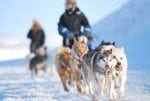This trip is for those of you who are looking for Arctic challenges and who want to be one with nature. During this trip you may experience sunshine or perhaps a snowstorm you travel on the sea ice, over beautiful glaciers and in the deep powders you may encounter polar bears, seals or reindeer. You will also experience Spitsbergen’s highest mountain peak – Mount Newton. The trip is not for everyone, you need to be relatively healthy and fit, and not in too bad shape. This is a journey and an adventure where you are active and help to set the camp, feed the dogs and make sure the camp life works at its best. An experience for life!
Contact form

Ecorating: 3.0
This product meets our requirements for Ecorating, a product that is good for humans and the environment.
Does my trip make a difference?
Read more
This product meets our requirements for Ecorating, a product that is good for humans and the environment.
Sample Itinerary
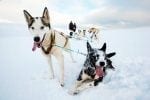
The day starts at 08:30 with departure by boat from Longyearbyen and we then arrive at Nordenskiöld Lodge in Billefjorden. We spend the rest of the day getting to know the dogs and our equipment, and we learn the basic principles of traveling with a dog sled and Arctic conditions. The safety of the expedition is our highest priority, and therefore we set certain rules for the expedition: weather and snow conditions are taken into account and then we must remember that this is the polar bear’s natural habitat and hunting grounds. In the evening we enjoy a good dinner in the lodge before crawling into our warm and comfortable beds. Accommodation in a double room at Nordenskiöld Lodge.
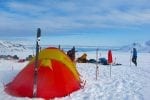
After breakfast we prepare our dogs for departure, and begin our expedition to Mount Newton. The dogs are eager, and together we travel further and further into the Arctic landscape. The Arctic wilderness and great nature experiences await us. The route goes to the impressive Nordenskiöld glacier. At the top of the glacier we can enjoy a fantastic view of the Billefjord. Before nightfall, we set up a basecamp, prepare and have a nutritious evening meal and crawl into a warm sleeping bag. Accommodation in tents.
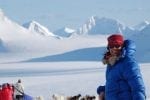
In the morning, when the dogs start to get restless, it’s time to head out into the snowy desert again. Both dogs and humans get a hearty round of breakfast, and then we leave. Weather permitting, we will reach the foot of Mount Newton in the afternoon. It is an impressive mountain we want to conquer – the highest mountain in Spitsbergen! We camp in the evening and relax and gather energy – tomorrow will be a pretty hard day. Accommodation in tents.

Today we climb quite a few meters all the way up to the top of Mount Newton. If the weather is clear from the mountain top, we can look far over to the northern side of the archipelago and feel the brutal but beautiful Arctic nature around us. The goal is to have lunch on Svalbard’s highest mountain – 1,713 meters above sea level! This is an experience that quite a few people get to experience. We come down from the mountain during the afternoon and we have to hurry a bit – the camp must be ready at the foot of the mountain before it gets dark. Accommodation in tents.
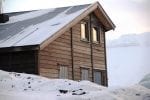
At present we have become acquainted with each other and the dogs. We will again pack our camp together and return to the large and open glaciers. After many days in a tent, you are probably looking forward to a hot sauna, fire in the fireplace and soft beds waiting for us at Nordenskiöld Lodge. Upon arrival at the lodge we take care of the dogs and then we can finally enjoy the evening. Accommodation in a double room at Nordenskiöld Lodge.
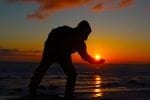
After breakfast, it’s time to say goodbye to your loyal dog team and lodge. You take the boat back to Longyearbyen and civilization. Arrival at Basecamp Hotel in the afternoon. We can guarantee you that you will come home with lots of great memories in your luggage!
Trip details
Ecorating: 3
When can you travel?March and April
Travel duration: 6 nights
Minimum age: 18 years
Airport: Longyearbyen, Svalbard, Norway
Price includes: accommodation, meals and activities as per program
Price does not include: Drinks for meals, activities outside the program, transfer from airport by airport bus, climate compensation 250 NOK
Good to know about Svalbard
Despite Svalbard’s northern location, the archipelago has a relatively mild climate compared to other areas at the same latitude. In summer the temperature is around 5 ° C and usually very little rain, but it is quite common with fog and low clouds. Although it rarely rains, the ground is often wet due to the melting snow. Cold winds are common, even in summer. It must be remembered that the weather on Svalbard can change quickly and local temperatures can vary greatly.
In winter, the average temperature is -14 ° C. Temperatures between -20 and -30 degrees are not uncommon. In combination with wind, temperatures can be extremely low.
Longyearbyen has midnight sun from 19 April to 23 August. During this bright period, the sun never goes below the horizon. In contrast, from late October to mid-February, the sun never appears above the horizon. The dark polar nights last from mid-November to the end of January, and during this period you can not distinguish day from night.
Visa:
Time Zone: GMT +1
Vaccination: No vaccinations required.
Packing: With the right packing, plenty of food and good daily routines, you can stay warm, even on cold days. This is of course important so that you can enjoy your Arctic adventure. We recommend everyone to wear wool and stock in stock, wool socks in both summer and winter season. The wind on Svalbard can be strong, and if it blows over the glacier it can feel very cold.
Packing list: We recommend that you bring the following equipment: A solid backpack, bag for personal belongings, warm windproof jacket and trousers, warm down jacket / parka, warm windproof hat, 2 pairs of wool gloves, 1 pair of windproof gloves, 1 pair of work gloves (when handling dogs, etc.), 2 sets of wool underwear and sweater, warm wool or fleece jacket, wool or fleece trousers, 2-3 pairs of wool socks, toiletries, sunglasses, binoculars and camera. Due to limited space in the sleds, we recommend that you bring a minimum of luggage (the remaining luggage can be stored at the Basecamp Trappers Hotel).
Equipment: All guests receive a warm overall, snow boots, windproof gloves, face mask, goggles and a warm hat. In addition, warm sleeping bags, sleeping pads, tents and necessary camping equipment will be included. Our experienced guide takes care of the guests’ safety and brings all the necessary safety equipment.
Local currency: Norwegian kroner
Weather:
Mobile coverage and internet: The mobile network works well in Norway. Basecamp management recommends that you use your phone discreetly or turn it off.
Safety: Safety instructions are provided on site when you arrive and it is VERY important to follow them. Meeting a polar bear is a great experience, but can also be extremely dangerous situation. All guides are armed around the clock for your safety.

Ecorating: 3.0
This product meets our requirements for Ecorating, a product that is good for humans and the environment.
Does my trip make a difference?
Read more
This product meets our requirements for Ecorating, a product that is good for humans and the environment.
At Basecamp Spitsbergen, people are particularly concerned about the global warming of the planet, as it is most visible in our polar regions. The biggest project we can contribute to address this is by planting trees in Kenya. All guests are encouraged to participate in the project. By planting trees, we can reduce CO2 emissions globally. Your contribution is 250 NOK, which is equivalent to being able to plant 8 trees in Kenya.
In Svalbard, you use as few resources as possible, and use organic products to keep your environmental footprint as small as possible.
At Isfjord Radio an indoor herbal garden has been initiated that supplies the chef with fresh herbs and supplements for the guests’ meals, saving CO2 emissions.
Basecamp Explorer Spitsbergen has also supported the Kapp Linne information project on how to raise awareness on the valued bird sanctuary and its birdlife, managing visitors when experiencing the reserve.
Basecamp Explorer Spitsbergen regularly takes part in clean up activities around the islands.
